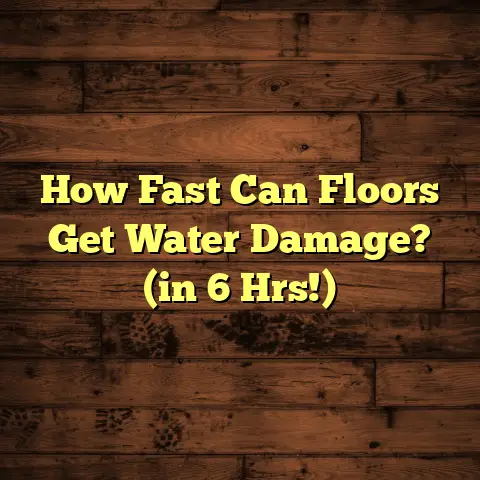Dry Floor After Leak? (5 Urgent Drying Mistakes!)
Imagine this: You walk into your living room
and squish.
Not a pleasant feeling, right?
A pipe burst, the washing machine overflowed,
or maybe a storm surge found its way inside.
Chaos. Pure, unadulterated chaos.
But what happens next is crucial.
Ignoring that water, or even worse, trying
to fix it with the wrong methods, can lead
to a disaster far bigger than the initial leak.
Mold creeping up your walls,
floorboards warping like crazy,
and even structural damage that could cost
you a small fortune.
And let’s not forget
the health risks, especially for those
with allergies or respiratory issues.
Have you ever wondered why some houses seem to bounce back effortlessly from water damage, while others become a breeding ground for mold and decay?
The answer often lies in those critical
first 24-48 hours.
That’s why I’m here to
walk you through the most common, and
costly, mistakes people make when trying
to dry out their floors after a leak.
Trust me, I’ve seen it all in my years
as a flooring contractor.
And I want to
help you avoid these pitfalls and protect
your home and your health.
Let’s dive in!
Section 1: Understanding Water Damage
So, what exactly is water damage?
It’s any kind of destruction caused by water
where it shouldn’t be.
Think about it: a slow drip under your sink,
a flash flood, or even a seemingly minor
leak in your roof.
All of these can lead to
serious problems if left unchecked.
Where does water damage come from?
Well, the sources are pretty varied:
- Plumbing Issues: Leaky pipes, burst pipes,
overflowing toilets – the usual suspects. - Natural Disasters: Floods, hurricanes,
heavy rains, and even snowmelt can wreak
havoc on your home. - Appliance Malfunctions: Washing machines,
dishwashers, refrigerators – when these go
wrong, they can release a lot of water fast. - Roof Leaks: Even a small hole in your roof
can let in enough water to cause significant
damage over time.
Now, let’s talk about what happens when
water meets your flooring.
It’s not a pretty
picture, especially depending on the material.
- Hardwood: This is like a sponge.
It soaks
up water, causing it to swell, warp, and
even cup.
I’ve seen hardwood floors buckle
so badly they looked like waves. - Carpet: A breeding ground for mold and
mildew.
It traps moisture, making it incredibly
difficult to dry properly.
Plus, the padding
underneath can stay wet for weeks. - Tile: While tile itself is waterproof, the grout
lines aren’t.
Water can seep through and
damage the subfloor underneath. - Laminate: This stuff is particularly vulnerable.
Water can cause the layers to separate and
the edges to swell.
Once laminate gets wet,
it’s often ruined.
The key takeaway here is this: immediate
action is crucial.
I can’t stress this enough.
The longer water sits, the more damage it causes.
Think of it like a ticking time bomb.
The longer you wait, the bigger the explosion
(and the bigger the repair bill).
Ignoring water damage can lead to:
- Mold Growth: This can start within 24-48
hours and cause serious health problems.
According to the EPA, mold exposure can
cause nasal stuffiness, throat irritation,
coughing or wheezing, eye irritation, or,
in some cases, more serious effects.
[EPA Mold Website]
(https://www.epa.gov/mold) - Structural Damage: Rotting wood, weakened
foundations – this can compromise the
integrity of your entire home. - Costly Repairs: Replacing flooring, repairing
walls, and dealing with mold remediation
can quickly add up to thousands of dollars.
So, now that we understand the gravity of the situation, let’s talk about those common mistakes and how to avoid them.
Section 2: Mistake #1 – Not Acting Quickly Enough
Time is of the essence. I mean it.
This is probably the biggest mistake I see
homeowners make.
They see the water, maybe
mop it up a bit, and think, “It’ll dry on its own.”
Wrong!
Every minute counts when it comes to water
damage.
The longer water sits, the more
damage it causes.
It’s not just about the
flooring; it’s about the walls, the subfloor,
and everything else that water can seep into.
Let’s get some facts in here.
According to the Institute of Inspection,
Cleaning and Restoration Certification (IICRC),
mold can start to grow within 24 to 48 hours
in the right conditions.
That’s not a lot of time!
And the longer you wait, the more difficult and expensive it becomes to remediate the damage.
Think of it like this: a small leak that’s addressed immediately might only require some basic drying and cleaning.
But a leak that’s left for a week could lead to extensive mold growth, requiring professional remediation and potentially the replacement of entire sections of flooring and walls.
I remember one case where a homeowner had a small leak under their kitchen sink.
They noticed it but figured it wasn’t a big deal
and put off dealing with it.
A week later,
they discovered a massive mold infestation
behind the cabinets.
The cost to remediate the mold and repair the
damage was over $10,000!
If they had acted
quickly, they could have saved themselves
a lot of money and a major headache.
Another example I saw was a business owner who had a pipe burst in their office building over a weekend.
By the time they discovered it on Monday morning, the carpet was soaked, the drywall was saturated, and mold was already starting to grow.
They had to shut down their business for several days while the damage was repaired, resulting in lost revenue and a huge disruption.
So, what should you do immediately after discovering a leak?
- Stop the Source: Turn off the water supply
to the affected area.
This is the most
important first step. - Assess the Damage: Determine the extent
of the water damage and identify any potential
hazards, such as electrical wires. - Contact Your Insurance Company: File a
claim as soon as possible. - Start Drying: Begin the drying process
immediately.
This means removing standing
water, opening windows and doors, and using
fans and dehumidifiers. - Call a Professional: If the damage is
extensive or you’re unsure how to proceed,
call a professional water damage restoration
company.
Don’t delay. Every minute counts!
Section 3: Mistake #2 – Using the Wrong Tools
Okay, you’ve sprung into action.
Great!
But are you using the right tools for the job?
This is another common mistake I see.
People often try to dry their floors with
things they already have on hand, like towels
and regular household fans.
While these might help a little, they’re simply not effective enough to properly dry out floors and prevent mold growth.
Let’s break down why these common household items fall short:
- Towels: Sure, towels can soak up some
surface water, but they quickly become saturated
and can’t remove moisture from deep within
the flooring or subfloor.
You’d need an
unrealistic mountain of towels to do the job
properly. - Household Fans: These fans circulate air,
which can help with evaporation, but they
don’t remove moisture from the air.
In fact,
they can actually spread the moisture around,
potentially leading to mold growth in other
areas.
So, what are the right tools for drying floors after a leak?
- Dehumidifiers: These are essential for
removing moisture from the air.
They work by
drawing in moist air, condensing the water,
and then blowing out dry air.
This helps to
lower the humidity levels in the affected area,
which is crucial for preventing mold growth. - Air Movers (aka Industrial Fans): These
are high-powered fans that create a strong
airflow across the surface of the floor.
This helps to evaporate moisture more quickly
and prevent it from seeping deeper into the
flooring. - Moisture Meters: These devices measure
the moisture content of different materials,
such as wood, drywall, and carpet.
They’re
essential for determining whether the drying
process is complete and for identifying
hidden moisture pockets.
Let’s compare the effectiveness of these tools.
You might be thinking, “Do I really need all this fancy equipment?”
Well, it depends on the extent of the damage.
For small leaks, a dehumidifier and a couple
of air movers might be enough.
But for larger leaks or if you’re dealing with materials like carpet or hardwood, you’ll definitely want to invest in the right tools or hire a professional who has them.
I remember one homeowner who tried to dry
their flooded basement using only household
fans.
After a week, the walls still felt damp,
and they started to notice a musty smell.
They finally called a professional, who used
dehumidifiers and air movers to properly dry
out the basement.
They also discovered
hidden mold growth behind the drywall, which
had to be remediated.
In the end, they spent more money than they would have if they had called a professional in the first place.
So, don’t skimp on the drying equipment.
It’s an investment in protecting your home
and your health.
Section 4: Mistake #3 – Ignoring the Underlying Issues
You’re drying the floor, that’s great, but…
Did you find the source of the leak?
And are you sure there’s no hidden water damage?
Ignoring these underlying issues is a recipe
for disaster.
I’ve seen it happen time and time again.
Let’s say you have a leaky pipe under your sink.
You mop up the water on the floor, dry it with
a fan, and think you’re done.
But what about the water that seeped into the
cabinet?
Or the water that ran down the wall
and into the subfloor?
If you don’t address these hidden areas, they can become breeding grounds for mold and cause serious structural damage.
That’s why identifying and addressing the
source of the leak is absolutely crucial.
If you don’t fix the underlying problem,
you’ll just be dealing with water damage again
and again.
And ignoring hidden water damage can have serious consequences:
- Mold Growth: Mold thrives in damp, dark
places.
Hidden water damage provides the
perfect environment for it to grow. - Structural Damage: Water can rot wood,
weaken drywall, and corrode metal.
This can
compromise the structural integrity of your
home. - Health Problems: Mold exposure can cause
a variety of health problems, including
allergies, asthma, and respiratory infections.
So, how do you inspect for hidden moisture?
- Visual Inspection: Look for water stains,
discoloration, or warping on walls, ceilings,
and floors. - Smell Test: A musty odor is a telltale
sign of mold growth. - Touch Test: Feel for dampness on walls,
floors, and other surfaces. - Moisture Meter: Use a moisture meter to
check the moisture content of different materials.
Where should you look for hidden moisture?
- Behind Walls: Check behind drywall,
especially in areas where there are pipes or
plumbing fixtures. - Under Flooring: Check under carpets,
hardwood floors, and tiles. - Inside Cabinets: Check inside cabinets,
especially under sinks and around dishwashers. - In the Attic: Check for leaks in the roof
and around chimneys. - In the Basement: Check for leaks in the
foundation and around windows.
When should you seek professional help?
- If you’re unsure how to proceed.
- If the damage is extensive.
- If you suspect mold growth.
- If you have health concerns.
A professional water damage restoration company has the expertise and equipment to properly assess the damage, identify the source of the leak, and dry out your home completely.
They can also help you with mold remediation and structural repairs.
Don’t take chances when it comes to water
damage.
It’s always better to be safe than sorry.
I recall a situation where a homeowner
experienced a small roof leak during a storm.
They patched the roof themselves and thought
they had solved the problem.
However, they didn’t realize that water had
seeped into the attic insulation and behind
the drywall.
Over time, the hidden moisture
led to a significant mold infestation, which
caused health problems for the family.
They eventually had to hire a professional mold remediation company to remove the mold and repair the damage, which cost them thousands of dollars.
If they had inspected for hidden moisture and addressed the underlying issue earlier, they could have avoided a lot of headaches and expenses.
Section 5: Mistake #4 – Skipping the Cleaning Process
You’ve dried the floor, found the leak,
fixed it, and think you’re done?
Not quite!
Cleaning and sanitizing the affected areas is a crucial step that many people skip.
And trust me, you don’t want to skip this step.
Why is cleaning so important?
Because water damage can create the perfect environment for mold and bacteria to grow.
Even if you’ve dried the area thoroughly,
there may still be microscopic mold spores
or bacteria present.
These can multiply quickly
and cause health problems, especially for
those with allergies or respiratory issues.
Think about it: floodwater can contain sewage,
chemicals, and other contaminants.
Even clean
water can harbor bacteria and mold spores.
That’s why it’s essential to clean and sanitize all affected areas to prevent mold and bacteria growth.
What are the steps for properly cleaning different types of flooring post-leak?
- Hardwood:
- Vacuum the floor to remove any debris.
- Clean the floor with a wood cleaner
specifically designed for hardwood floors.
Avoid using excessive water, as this can
damage the wood. - Sanitize the floor with a diluted bleach
solution (1 part bleach to 10 parts water).
Be sure to test the solution in an
inconspicuous area first to ensure it
doesn’t damage the finish. - Dry the floor thoroughly with clean towels.
- Carpet:
- Remove as much water as possible with a
wet/dry vacuum. - Clean the carpet with a carpet cleaner and
a steam cleaner. - Sanitize the carpet with a carpet sanitizer.
- Dry the carpet thoroughly with fans and
dehumidifiers.
- Remove as much water as possible with a
- Tile:
- Clean the tile with a tile cleaner.
- Scrub the grout lines with a grout brush
and a grout cleaner. - Sanitize the tile and grout with a diluted
bleach solution (1 part bleach to 10 parts water). - Rinse the tile and grout with clean water.
- Dry the tile and grout thoroughly with
clean towels.
- Laminate:
- Vacuum the floor to remove any debris.
- Clean the floor with a laminate floor cleaner.
Avoid using excessive water, as this can
damage the laminate. - Sanitize the floor with a diluted bleach
solution (1 part bleach to 10 parts water).
Be sure to test the solution in an
inconspicuous area first to ensure it
doesn’t damage the finish. - Dry the floor thoroughly with clean towels.
It’s important to use the right cleaning
solutions and methods.
Referencing health
and safety guidelines is also essential.
- Always wear gloves and eye protection
when cleaning with bleach or other
harsh chemicals. - Ensure adequate ventilation when cleaning.
- Follow the manufacturer’s instructions
for all cleaning products. - Never mix bleach with ammonia, as this
can create toxic fumes.
I had a client who experienced a minor
flood in their basement.
They dried the
area thoroughly but didn’t clean or
sanitize it properly.
A few weeks later, they started to notice
a musty smell and discovered mold growing
on the walls and floors.
They had to hire
a professional mold remediation company
to remove the mold and clean the area,
which cost them a significant amount of money.
If they had taken the time to clean and sanitize the area properly in the first place, they could have avoided this costly problem.
Section 6: Mistake #5 – Neglecting to Monitor Humidity Levels
Alright, you’ve dried, cleaned, and sanitized.
You might think you’re in the clear.
But there’s one more crucial step:
Monitoring humidity levels.
Why is this so important?
Because even after you’ve removed the standing water and dried the surfaces, there may still be residual moisture in the air and in hidden areas.
High humidity levels can create the perfect environment for mold and bacteria to grow, even if you’ve already cleaned and sanitized.
And different flooring materials react differently to humidity.
- Hardwood: High humidity can cause
hardwood floors to swell and warp. - Carpet: High humidity can trap moisture
in the carpet fibers, leading to mold growth. - Tile: High humidity can promote mold
growth in the grout lines. - Laminate: High humidity can cause the
layers of laminate flooring to separate.
So, how do you measure humidity levels in your home?
- Hygrometer: This is a simple and
inexpensive device that measures the
relative humidity in the air.
You can
purchase a hygrometer at most hardware
stores or online. - Smart Thermostat: Some smart thermostats
also measure humidity levels. - Professional Moisture Meter: A professional
water damage restoration company can use
a moisture meter to measure the moisture
content of different materials and identify
hidden moisture pockets.
What are the optimal humidity levels during and after the drying process?
- During Drying: Aim for a relative humidity
level of 30-50%. - After Drying: Maintain a relative humidity
level of 30-50% to prevent mold growth.
How can you maintain optimal humidity levels?
- Use a Dehumidifier: A dehumidifier will
remove moisture from the air and help to
lower humidity levels. - Ventilate Your Home: Open windows and
doors to allow fresh air to circulate. - Use Air Conditioning: Air conditioning
can also help to lower humidity levels. - Fix Leaks Promptly: Repair any leaks
immediately to prevent water damage. - Improve Drainage: Ensure that your home
has proper drainage to prevent water from
pooling around the foundation.
I worked with a homeowner who had a small
leak in their bathroom.
They dried the
area thoroughly and cleaned it, but they
didn’t monitor the humidity levels.
A few weeks later, they started to notice
a musty smell and discovered mold growing
on the walls and ceiling.
The humidity
levels in their bathroom were consistently
above 60%, which created the perfect
environment for mold to grow.
They had to hire a professional mold remediation company to remove the mold and install a dehumidifier to maintain optimal humidity levels.
Conclusion
Okay, we’ve covered a lot of ground here. Let’s recap those five costly mistakes:
- Not Acting Quickly Enough: Time is of the essence.
- Using the Wrong Tools: Invest in the right equipment.
- Ignoring the Underlying Issues: Find and fix the source of the leak.
- Skipping the Cleaning Process: Clean and sanitize to prevent mold.
- Neglecting to Monitor Humidity Levels: Keep humidity in check.
Avoiding these mistakes can save you a lot
of money, time, and stress.
More importantly,
it can protect your home and your health.
Remember, water damage is a serious issue, but it’s one that you can tackle with the right knowledge and tools.
Be proactive.
Be informed.
And don’t hesitate
to call a professional if you’re unsure how
to proceed.
Your home is your sanctuary. Protect it!
Call to Action
Now, I want to hear from you!
Have you ever dealt with water damage in
your home?
What were some of the challenges
you faced?
What did you learn from the experience?
Share your stories in the comments below.
Let’s create a community of shared knowledge
and support.
And if you found this article helpful, be sure to subscribe to my newsletter and follow me on social media for more tips on home maintenance and disaster preparedness.
Stay safe and dry out there!





